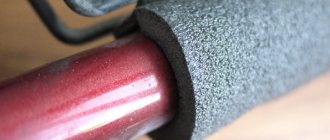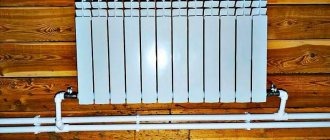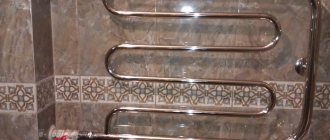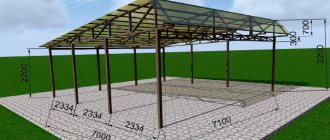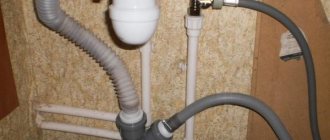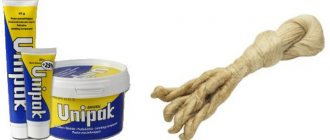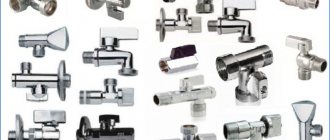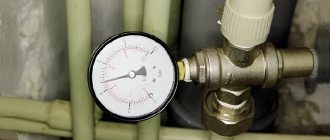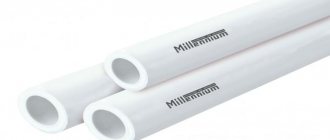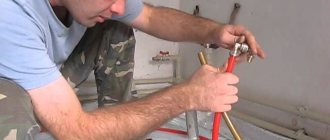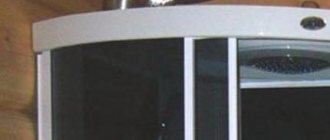To ensure water supply outside the city limits, you can use various methods: digging wells, drilling and constructing wells, but the best option is to connect a private house to the central water supply. When carrying out this procedure, significant financial investments and large volumes of work will not be required; the water will have a stable pressure and quality tested by sanitary services.
The greatest difficulty that connection to the central water supply will cause is the need to formalize a large package of documents with permits and approvals. In order not to use rumors that lead to erroneous actions and loss of time, it is important to know the regulations and decrees approved by law that regulate the procedure for connecting residential buildings to the central water supply main.
Fig. 1 Examples of a standard contract
Rules for connecting a house to the central water supply
The fundamental document regulating the connection to a centralized water supply line is government decree No. 644 dated July 29, 2013, which defines the rules for cold water supply and drainage.
Its main provisions consist of the following points:
- In addition to the above-mentioned document No. 644, the procedure for connecting objects is determined by the federal laws on urban planning and “On water supply and sanitation.” The basis for installation work is a standard contract for connection to a centralized water supply main.
- An applicant wishing to join a centralized water supply system or significantly increase the volume of water consumption is required to submit an application to the territorial authorities. Within 5 days (the calculation period is carried out only in working days), he is required to provide data, based on the water supply scheme in the given area, about the organization involved in water management in the territory where the connected residential building is located.
- Then representatives of local authorities or the customer himself contact the water utility to issue technical conditions for tapping into the central water supply. If the customer knows the required volume of water supply, then he can submit an application to the water utility for concluding an agreement, collecting the necessary package of documents, without waiting for receipt of technical conditions.
- The service that has the right to carry out work under the contract is the organization that issues the technical conditions and the corresponding permit, its legal successor or the owner of the water supply main. After accepting the documents, she must verify them within 3 working days according to the list below. In addition, the balance ratio of drainage and water supply, the technical feasibility of carrying out measures taking into account the height (number of floors) of the facility, and the section of the pipeline where the tie-in should be made are determined.
- If the documents were received incompletely or incorrectly, the balance is incorrect, or the pressure characteristics of the source water main do not supply water to the specified number of floors, the authority sends a notification to the customer no later than 3 days. It states that within 20 days the customer is obliged to provide the missing information or change the requirements for documentation, that is, correlate them with the technical characteristics of the line.
- If new or changed data is not received within 20 days, the application is canceled, of which the customer receives notification within 3 days after the decision is made.
- If all documents are provided and it is technically possible to carry out installation operations, the water utility sends the connection agreement, technical conditions and payment calculation to the customer within 20 days.
Rice. 2 Example of pipe layout to which plumbing fixtures are connected
- The legislation does not allow the water supply service to refuse to draw up an agreement and fulfill obligations to connect to the line if it is technically possible.
- If connection to the line is impossible for technical reasons, an individual project is drawn up that allows this work to be performed using another method.
- In accordance with the standard agreement, payment is made in the following amounts and order:
- 35% within 15 days after drawing up contractual documents;
- 50% within 90 days during the work, no later than its actual completion;
- 15% within 15 days after drawing up and signing the final acts, which are a guarantee of the technical ability to supply water to the customer no later than its actual receipt.
- The water supply contract is drawn up for the period specified in it and can be extended automatically one month before the end of its term, unless the parties have declared its suspension or change.
What documents need to be collected and prepared?
The basis for drawing up a cold water supply contract is an application on behalf of the customer or his representative acting by proxy, or an offer from a water supply service chosen by the customer.
The application must include the following information:
- Subscriber details:
- For individuals - postal address of registration or place of residence, full name, passport details or other identity document, contact information.
- For legal entities and individual entrepreneurs - registration number in the State Register and the date of its entry, location indicating the postal and registration address at the place of residence, individual tax payer number (TIN), bank details and documents confirming the subscriber’s right to sign business documentation.
- The name and location of the object in respect of which the contract is being drawn up.
- Information about other sources of water intake, indicating the volume and owners through whose networks water is supplied.
- If standards are established for the customer for the disposal of sewage water in cases where there are no septic tanks for dachas and country houses on the site, their composition and properties are indicated in the dynamics of changes over the year.
- The area of the customer’s individual plot with the objects located on it and its characteristics.
- Data on the type of activity in the case of regulated spillways.
The list of papers submitted with the application includes the following documents:
- A photocopy of the certificate of property rights to the object or device connected to the water supply line, necessary for connection to the system.
- A copy of the passport or other document confirming the subscriber’s identity. Power of attorney for drawing up business papers, if the customer is acting as his authorized representative.
- Standard documents established by law for organizations, partnerships, housing cooperatives when drawing up agreements with resource-supplying authorities.
- Information needed to calculate consumed volumes - the area of irrigated land, housing and auxiliary premises, the number of floors of buildings, the number of residents.
- Photocopies of documents and previously concluded contracts for connecting the subscriber to the water supply main.
- Photocopies of reports on connection, washing and disinfection of lines and equipment on the customer’s territory inside the house and on an individual plot when connecting to the water supply main.
- Photocopies of papers for water meters to verify compliance with their legal requirements, installation diagram and information about their readings at the time of drawing up the contract. The norm does not apply to consumers with a intake volume of less than 0.1 cubic meters per hour and when the installation of meters is optional.
- Sampling site diagram.
- Photocopies of documents confirming ownership of an individual land plot.
- Balance of maximum consumption indicating the intended use and load according to needs (for household needs, fire protection, filling swimming pools, periodic water consumption for irrigation).
- A positive expert decision from a federal or private examination in cases where it is required by law.
- Documentary photocopies of papers about other sources of water supply, contracts with water supply services and their licenses for the use of subsoil, indicating the volume of supply.
We draw up project documentation
Drawing up a project may be necessary if a residential building is undergoing a major overhaul with redevelopment or if it is recently built. To develop it based on the received technical conditions, you can contact private architectural firms or designers of the organization that owns the water source.
When compiling it, the number of residents in the house, the volume of water consumed, the location of bathrooms and household appliances, and the presence of other sources of water are taken into account. When developing a project, the design organization will need a site and house plan (drawings of a residential building and a topographic survey of the site), the type of plumbing used in the housing, and a list of operational requirements.
The finished project should answer questions about:
- choosing a wiring diagram for cold and hot water when using a water intake source for a heating system;
- selection of pipe materials and sizes;
- the thickness of the screed if the water main is located in the floor;
- the amount of materials and plumbing fittings required for installation work;
- pressure - are booster pumps required for wells?
The customer must receive from the organization that has the right to draw up project documentation a document with the following content:
- title page with general data and explanatory note;
- master plan with the layout of the main water main;
- diagram of the water supply line in the house, indicating the main components and placement points of shut-off valves;
- axonometric diagram of the water supply and boiler room;
- specification of the materials used and plumbing fittings.
Fig.4 Connecting a private house to the central water supply - example of a project
Drafting
Scheme of connecting areas to the water supply system
To design the water supply, you will have to involve specialists - the water utility design team. It will consist of the following elements:
- estimate with a statement of resources;
- graphic display of the plan and explanatory note;
- custom specification.
The design of the insert occurs according to the following plan:
- A 1:500 site plan is submitted to the water utility.
- They draw up an application for connection to the water supply, attach documents on land ownership and property rights. A month later they receive a refusal or approval with connection conditions: pipe diameter, insertion location.
- They contact the health authority along with the received documents and draw up an application to receive a conclusion on the insertion.
- They draw up a connection project and register it with the sanitary station.
- The utility system, based on documents, issues permission to carry out construction and land work.
After this, they begin to implement the project, attracting licensed services to dig trenches and insert into the canal pipe.
Main points of the contract and necessary acts
In order to achieve connection to the water main with official permits and approvals, you need to draw up an agreement with the water utility, which includes the following provisions:
- registration of the subject of the contract - cold water supply and its supply mode (pressure in the main line and volume) in accordance with individual technical conditions;
- period of water supply to the consumer;
- quality indicators of cold water;
- procedure for monitoring quality characteristics;
- list of conditions for short-term suspension of water supply;
- water consumption accounting system;
- terms and conditions of payments for water consumption;
- division of responsibility for the operation of the water utility and the consumer through water supply networks;
- contractual rights and obligations of the consumer and the water utility regarding the provision of water;
- liability of the parties for failure to fulfill their contractual obligations;
- the procedure for resolving controversial issues, disagreements between the consumer and the water supply service and their settlement;
- the procedure for providing access to water utility representatives to water sampling points and metering devices to control water consumption;
- terms and methods for submitting data on water consumption by the subscriber in the presence of individual metering devices;
- the procedure for informing the water utility when transferring rights to other persons or business entities for objects in respect of which contract documents have been drawn up;
- conditions for supplying water to entities connected to the subscriber’s water supply line under contractual obligations with the water utility.
After installing the water supply system in the house, an act of work carried out by the contractor is drawn up, which is signed by the subscriber.
An act for hidden work is often drawn up (there is a special form for this) related to work during pipeline laying.
When the water supply systems connected to the house are flushed by sanitary and epidemiological services with further testing of water quality, a report is drawn up to verify that the source complies with sanitary and epidemiological standards.
Rice. 5 Connecting a private house to the central water supply by connecting to the water supply network using saddles
How to connect to a water supply and cut in a pipe
If the pipeline runs outside the individual section, then the organization that has the right to tap into it is a company that has the appropriate license or is a member of a self-regulatory organization (SRO) operating in this service sector.
Typically, along the path of the centralized pipeline there are wells every 100 meters, with bends placed on the pipeline, providing the technical ability to connect additional lines. The technical conditions for connection are given to the nearest well; if it is absent or the main line runs directly through the site, it is more practical to make your well from reinforced concrete rings (gas silicate is a short-lived option, and the use of brick is not economically feasible).
Connection diagram to the central water supply line
The diagram of how to connect a house to a water supply depends on its material of manufacture and includes adapter couplings along with metering devices. The insertion into the central water supply from HDPE pipes is carried out using special clamps; if the main is made of steel pipes that do not have fittings for connecting side branches, the insertion is made using clamps or welded threaded adapters.
When placing the entry point for the connected water in a special well, it must provide convenient access for technical supervision by specialists of the operating service.
Rice. 6 Tapping into a pipeline under pressure
- Reading about connecting a private house to the central water supply, it may also be interesting to learn about the security zone of the water supply and sewerage system
Advantages of centralized water supply
You can also supply water to your home from autonomous sources - wells, wells, natural reservoirs (read more here). This water supply option has many advantages, but its organization requires a lot of money and labor. And the quality of water, its pressure and provision of the required volume of liquid will become the sole concern of home owners.
However, connecting your home to a centralized water supply system is also not always the best solution. Especially if this system is already worn out or was not originally designed for a large number of consumers. In this case, both the quality of the supplied water and the main criteria for the normal operation of the water supply system - flow and pressure - may suffer.
Old networks and low pressure are a reason to think about autonomous water supply
If the system is new and modern, and runs close to your site, then you cannot find a better source. Connecting to it provides a huge advantage compared to installing a well or well.
- The money savings in this case are very noticeable. To connect an individual house to the water supply of a populated area, you will have to pay much less than to drill a well or dig a well and then equip them with pumping equipment and water treatment systems.
- The savings in time and labor costs are also obvious. And not only at the construction stage, but also during operation: the resource supplier will be responsible for the normal operation of the equipment and its repair.
- The quality of water and its compliance with sanitary and hygienic standards is also not your concern. It is supplied to the consumer already purified and disinfected, which eliminates the need to install water treatment equipment in the house.
The only serious drawback can be considered the likelihood of water being turned off in the event of an accident or repair work on the highway, or insufficient pressure during peak hours. But such situations are not excluded when water is supplied from an autonomous source. The pump may break down, water may leave the well or its level may drop.
Advice. Regardless of the chosen water supply scheme, it is advisable to have a storage tank in the house for a reserve supply of water in case of a sudden shutdown or unforeseen breakdowns.
Connecting a private house to the central water supply - sequence of work
The house can be connected to the central highway without waiting to receive a plan for laying the pipeline; there are several ways to solve this problem.
Although the prerogative for connecting the water supply and tapping into the water main belongs to the water utility, which will have to shell out a considerable amount for one and a half to two hours of work, this work can be carried out with the help of specialists in other organizations or hired workers, subject to technical conditions. Connection to the water supply of a private house must be made in the following order:
- The method of cutting into the main line is selected; the simplest option is to use overhead clamps on the main line made of plastic or steel pipes. It should be noted that tapping into a pipeline under pressure involves the use of special devices based on the technique of drilling the pipeline through overhead clamps.
- The pipeline material is selected, which must be ordered in length from the point of water intake to the house; usually preference is given to light, durable and corrosion-resistant pipelines made of low-pressure polyethylene HDPE.
- The necessary metering devices and compression fittings are purchased, which are the main elements of the fittings for connecting the HDPE pipeline.
Rice. 7 Laying a pipeline with your own hands - carrying out excavation work
- A well is made of concrete rings in the place where the cutting is to be carried out; similarly, a hole of the required depth is dug near the foundation of the house, in which a hole is drilled to insert the pipe into the house.
- Using special equipment (trenchers, small excavators) or with your own hands, a trench of the required depth is dug into which the HDPE pipeline is placed. After adding sand to the trenches, the pipeline laid on a sand cushion is buried; at shallow burial depths, cable heating of the pipeline or thermal insulation is used, backfilling with non-heat-conducting materials (expanded clay).
- The HDPE pipe is connected to the main line through a fitting with a shut-off valve along with sealed metering devices, after which water can be supplied to the house.
We dig a trench to bring water into the house with our own hands
According to SP 22.13330.2011, for Moscow and the Moscow region the freezing depth for clay and loam is 1.1 m, and for fine sand and sandy loam - 1.34 m. For St. Petersburg and the Leningrad region - 1.0 m and 1.2 m, respectively.
In the middle zone of the Moscow and Leningrad regions, the depth of the trench ranges from 60 to 150 centimeters - depending on the depth of soil freezing (we always lay the pipe below the freezing depth!). At the same time, we do not consider the territories of our country with permafrost. The summer water supply option is 30 - 40 centimeters.
The width of the trench must be at least 30 centimeters. This is necessary for the convenience of laying the pipe, so that a person with an ordinary build can fit in the trench and be able to work in it.
We do not recommend skimping on trench depth. At the optimal pipe depth (about 1.5 meters), we use about 3 meters of heating cable per input. In rare cases, we can use a cable length of up to 6 meters: usually when the pipe entry is not made at the outer wall, but at a distance from it. Thus, this length will be enough for us to warm up the water at the pipe exit from the house (if the house is on stilts or on a strip foundation, then approximately 0.5 meters), as well as at a smooth exit to a depth below the freezing level (about 2 meters).
However, if the depth of the trench is higher than the freezing depth, then the heating cable will have to be laid along the entire length of the pipe, and this, in turn, is quite expensive: the cost of the cable, the cost of electricity. Also, when the cable becomes unusable, and to replace it you will have to dig out the entire trench.
For our clients, we always dig below the freezing depth, and use a heating cable to heat only the area where the pipeline enters the house.
Rules for laying pipes in a home
There are two main wiring methods - serial and parallel, each of them has its own advantages and disadvantages. In the first case, water supply equipment and plumbing fixtures are connected to the line in series; this technology saves pipe materials, but at the same time, the pressure at the most remote point can differ significantly from the indicators at the entrance of the line to the house.
With the collector method, more fittings and pipes are used, but the pressure in all branches is approximately the same. Piping is often laid using a mixed method, connecting closely located autonomous water supply equipment and plumbing fixtures in series into a branch of one line.
Rice. 8 Parallel (collector) wiring
Installation of water supply in a private house should be carried out according to uniform rules that specialists need to know; the information can also be useful for owners when carrying out work independently. The main points of the plumbing instructions are the following requirements:
- The pipeline must be located strictly vertically and horizontally, the lines must not intersect.
- When connecting sections of the main line using collapsible compression fittings, it is necessary to ensure free access to each junction point.
- A shut-off ball valve is installed at the inlet of each branch from the line.
- It is mandatory to install a sand filter at the entrance to the water main of the house.
- To maintain constant pressure, branches from the line are made of a smaller diameter than the main line.
Rice. 9 Method of serial wiring with connected water supply equipment
Separation based on water supply principle
Installation of a DHW and cold water system can be carried out in two ways:
- With “deaf” wiring. The water supply pipe to the last water intake point ends in a dead end. This scheme is more beneficial for saving space and from an economic point of view, but can create inconvenience during the operation of the water supply system. Water will flow into the last node with a delay, and only after it reaches the plug will it begin to flow into the tap.
- With closed circulation wiring. With this method, water constantly moves in a circle, has the same temperature at each point of the system and reaches the user immediately after opening the tap. The peculiarity of this wiring method is advisable to use specifically for a hot water supply system - it is important to prevent sudden temperature changes in it.
In order not to unnecessarily complicate the plumbing in the house, it is more rational to use a combined option. The cold water supply system is carried out with the help of blind wiring, the hot one - with the help of circulation.
A simple diagram immediately shows the differences between different water supply schemes: 1 - standard, “dead”; 2 - with forced circulation; 3 - “blind” using a collector
Which pipe and fittings to choose
As noted above, it is more rational to lay the pipeline using HDPE pipes, which are the most common. The distinctive features of this type of pipe are as follows:
- The products are designed to supply cold water with a temperature from 0 to 40 C;
- The maximum pressure range depends on the diameter and can reach up to 25 atmospheres.
- HDPE pipeline has a lower hydraulic resistance compared to metal products, which prevents the formation of salt deposits and silt on the walls during water circulation.
- Connection to the main line and pipes inside the house is made using compression fittings, ensuring ease of installation, high reliability and tightness of the connection.
- The pipe is supplied in coils of various lengths - this facilitates its transportation and installation.
- The service life of a HDPE pipeline without loss of its physical and chemical properties is about 50 years.
- Unlike metals, synthetic materials are resistant to corrosion and most harsh chemicals.
- Low-density polyethylene has low thermal conductivity - this prevents the water in the pipes from freezing in cold weather.
- Freezing of pipes rarely leads to rupture - they stretch without losing their integrity.
- Currently, the most common brands are PE80 or PE100, the latter has a high density and is used for the installation of water mains.
Rice. 10 HDPE pipes and fittings - appearance
You can officially connect to the main water supply in a private house after drawing up and signing a large number of documents that must be submitted to the water utility to draw up an agreement on connection to the water supply system. To save money, some of the work can be done with your own hands within an individual site - this is not prohibited by law if the installation is carried out in accordance with the technical conditions.
Briefly about the main thing
Before submitting an application that will allow the signing of an agreement with a company supplying water supply services, it is required to make a project of the site listing all equipment that consumes water and a topographic map.
Independent connection and installation of water supply must be officially authorized by the relevant services, otherwise administrative punishment will be received.
A connection to the general water supply network may not be necessary if it is possible to install a personal well, borehole and septic tank.
Ratings 0
